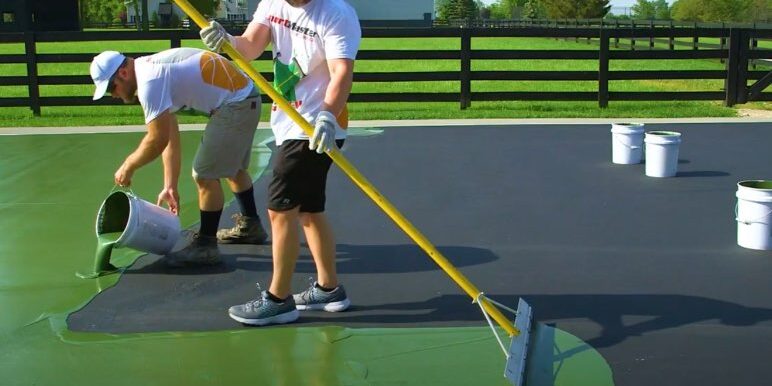Sustainable Practices in Pickleball Court Building You Need To Know
As the appeal of pickleball proceeds to rise, so too does the requirement for lasting practices in court building. This approach not only addresses ecological problems yet also enhances the durability and performance of the courts. From choosing eco-friendly products to applying reliable drain and energy-saving lights options, there are many methods to take into consideration. Yet, the impact of these techniques prolongs far past the court itself. Comprehending how each aspect adds to an extra sustainable future invites even more expedition right into the elaborate equilibrium between recreational growth and environmental stewardship.
Picking Eco-Friendly Materials
Choosing environmentally friendly products is an essential action in the construction of lasting pickleball courts. The choice of sustainable products not only decreases environmental influence but likewise improves the long life and efficiency of the court. Trick products consist of reused rubber for the surface area, which offers outstanding toughness and shock absorption while drawing away waste from land fills.
In addition, utilizing locally sourced materials reduces transport discharges and supports regional economies. Pickleball court construction. Utilizing native woods for secure fencing and seats can offer a lasting visual while making certain durability versus the elements.
Including permeable products for court foundations can even more add to sustainability by permitting natural water drain and decreasing drainage. These options not just protect neighborhood ecological communities however also advertise healthier play settings.
Efficient Drain Solutions
While the selection of eco-friendly materials is vital, implementing effective water drainage options is just as important for maintaining sustainable pickleball courts. Proper drain not just secures the court surface area from water damages but likewise decreases disintegration and drainage, advertising environmental stability.
Reliable drainage systems can include permeable paving, which allows water to penetrate the ground rather than merging on the surface area. This minimizes the probability of standing water, which can bring about mold and mildew and various other upkeep problems. Additionally, including strategically placed water drainage networks and swales can guide excess water far from the court area, making sure a dry playing surface area and preventing soil erosion.
Utilizing indigenous greenery in the landscape design around the courts can further enhance drainage by soaking up excess water and minimizing drainage. These plants need much less watering and promote biodiversity, lining up with lasting techniques.
Additionally, it is important to consistently maintain the water drainage system to guarantee its lasting effectiveness. This consists of clearing particles and monitoring for clogs. By focusing on effective drainage solutions, pickleball court constructors can significantly contribute to the sustainability and durability of the center, ultimately profiting both players and the setting.
Energy-Efficient Lighting Options
As the need for pickleball remains to expand, integrating energy-efficient lighting alternatives right into court style has ended up being significantly crucial for sustainability. Standard lights systems frequently consume excessive energy, adding to higher operational costs and environmental influence. Taking on contemporary, energy-efficient innovations is important for both new constructions and renovations.
LED (Light Emitting Diode) lighting stands out as a premier selection because of its long life and energy cost savings Read Full Report (Pickleball court construction). Compared to conventional lighting, LEDs make use of approximately 75% less power and can last as much as 25 times longer, considerably lowering maintenance expenses. Moreover, the directional nature of LED lighting lessens light air pollution, making sure that illumination is concentrated on the court instead than surrounding areas.

Lasting Surface Area Alternatives
Exploring lasting surface area options for pickleball courts has obtained grip amongst home builders and gamers alike. The focus on eco-friendly products not only aligns with the expanding ecological understanding yet likewise boosts the efficiency and sturdiness of the courts.
One popular choice is using recycled rubber, which can be sourced from used tires. This product offers excellent shock absorption, decreasing the danger of injuries for players while promoting sustainability. Additionally, modular tiles made from recycled plastics use another practical alternative. These tiles are easy to change and install, and their flexibility enables various court setups.
Natural lawn courts are additionally becoming a lasting choice, promoting biodiversity and reducing the heat island impact. Nevertheless, they call for normal maintenance and water, which may not straighten with all sustainability goals.

Water Conservation Techniques
One more effective method entails the installment of rainwater harvesting systems. These systems gather click resources and store rainwater for usage over here in keeping court surface areas and landscaping. This approach not just conserves potable water yet additionally decreases dependence on metropolitan resources.
Moreover, using drought-resistant landscape design around the courts is crucial. Native plants call for less water and are better adapted to local environment problems, therefore reducing overall water usage. Furthermore, making use of effective irrigation systems, such as drip irrigation, ensures that water is delivered directly to plant origins, reducing dissipation and waste.
Final Thought
Incorporating sustainable practices in pickleball court building and construction considerably adds to environmental conservation and resource effectiveness. By focusing on these practices, the building and construction of pickleball courts can line up with more comprehensive environmental goals while promoting long life and functionality within neighborhoods.
As the appeal of pickleball continues to climb, so also does the demand for lasting techniques in court construction.Selecting green products is a crucial action in the building and construction of sustainable pickleball courts. By focusing on energy-efficient lighting options, pickleball court fabricators can contribute to a more sustainable future while fulfilling the needs of stakeholders and players alike.Incorporating lasting surface options not only enhances the efficiency of pickleball courts but likewise leads the means for implementing effective water conservation methods.Incorporating lasting practices in pickleball court building and construction considerably adds to environmental conservation and resource performance.